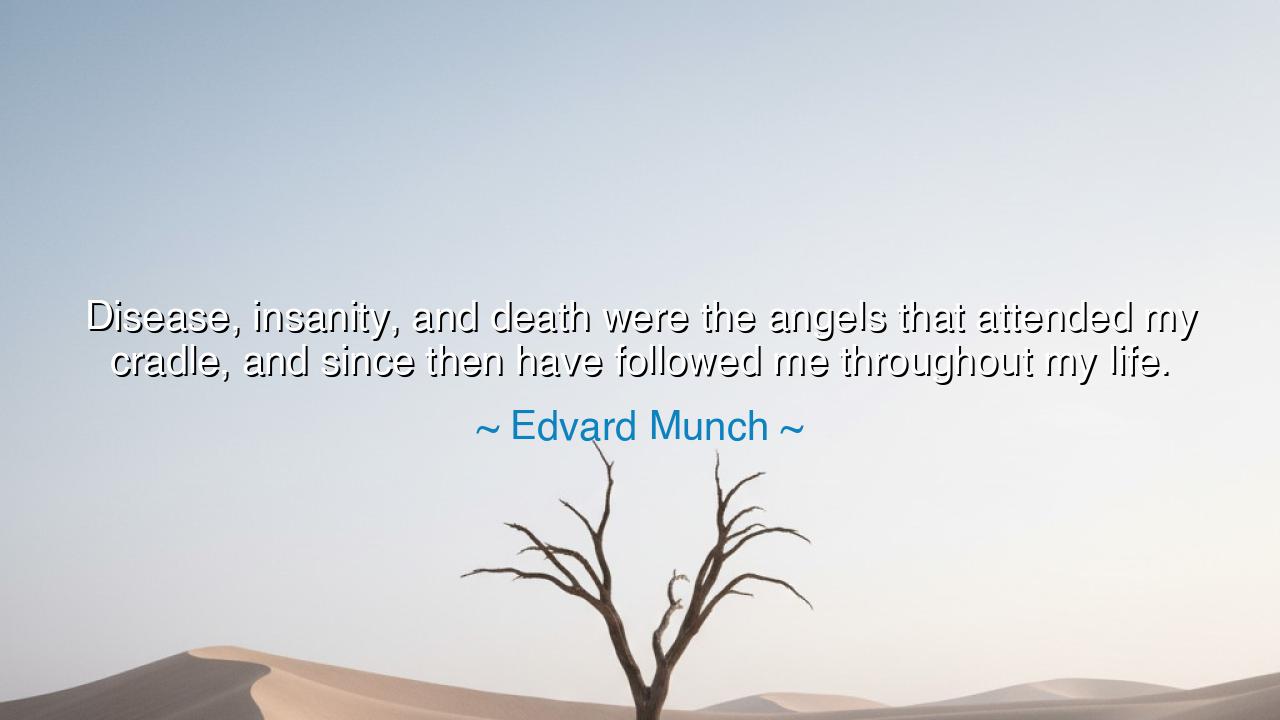
Disease, insanity, and death were the angels that attended my
Disease, insanity, and death were the angels that attended my cradle, and since then have followed me throughout my life.






“Disease, insanity, and death were the angels that attended my cradle, and since then have followed me throughout my life.” — thus spoke Edvard Munch, the painter whose art bled with anguish and beauty, whose soul saw the face of suffering and turned it into color and form. In these words, we do not hear despair alone, but the confession of one who lived with darkness as a companion, and who, instead of fleeing from it, learned to draw from its depths. Munch was no stranger to pain — he was its pupil, its witness, and ultimately, its translator. His quote is not a lament, but a revelation: that suffering is not merely a curse, but a relentless teacher, shaping the soul into something vast and true.
To understand these words, one must know the man who spoke them. Edvard Munch, the Norwegian master of expression, was born into a household shadowed by grief. His mother died of tuberculosis when he was but five years old, his beloved sister soon after; his father, a man of faith and fear, descended into melancholy; and madness would visit his family as faithfully as the winter wind. The child grew up surrounded by whispers of illness and loss — the three angels of his cradle: disease, insanity, and death. These, he said, “followed me throughout my life,” not as fleeting misfortunes, but as lifelong companions. Yet from their haunting presence, he created art that speaks across centuries — the cry of the soul that we know as The Scream, the shivering portrait of existence itself.
Munch’s words remind us of an ancient truth that the modern world often forgets: that the soul grows through struggle. In the mythology of the ancients, the greatest heroes are not those spared from suffering, but those transformed by it. Heracles found redemption through his labors; Job, in his torment, discovered the endurance of faith. So too did Munch’s art arise from affliction — his brush became his prayer, his canvas his confessional. His angels were terrible, yes, but they were also divine in their instruction, forcing him to confront what most men spend their lives avoiding: the fragility of flesh, the instability of mind, and the inevitability of mortality.
The “angels” he names are paradoxical beings — both destroyers and guides. They bring sickness to the body, torment to the spirit, and silence to the heart; yet in their shadow, truth becomes visible. Disease teaches the value of health; insanity reveals the thin veil that separates reason from chaos; and death, most feared of all, gives meaning to life’s brevity. Munch understood that these forces cannot be banished; they are the guardians of awareness, reminding humanity of its limits and its depth. The artist who denies them paints only surfaces; the one who embraces them — as Munch did — paints eternity.
Consider, for a moment, the story of Vincent van Gogh, another soul haunted by the same angels. He, too, wrestled with illness, loneliness, and madness, and from those struggles birthed the stars of The Starry Night. Like Munch, he turned inward pain into outward beauty, finding transcendence in torment. Both men lived lives of fracture, yet both saw what few could see — that creation and suffering are entwined. The fire that burns the soul can also forge it, if one dares to endure the heat.
Munch’s reflection is not only a testament to art, but to human resilience. To say that these angels followed him is to admit that he never escaped them — but also that he never surrendered. His life became proof that the human spirit can coexist with pain without being destroyed by it. In this, he offers a lesson that transcends the artist’s world: that we, too, must make peace with our shadows. The darkness that visits us — whether it comes as illness, grief, or despair — need not be our undoing. It can, if faced with courage, become the crucible of our strength.
So, my child, let this be the lesson: do not curse your suffering too quickly. The things that wound you may also awaken you. The angels of affliction that attend your life are not always your enemies; they may be your most honest teachers. Learn from them, and let their fire temper your soul. For those who walk with their pain, rather than run from it, discover a depth of compassion and clarity unknown to the unscarred.
As Edvard Munch teaches us, we do not choose the angels that visit our cradle — but we can choose what we create from their company. Whether you wield a brush, a word, a song, or simply the life you are given, let your pain be not a chain, but a torch. Let it light your path, and in time, you will see that what once seemed your burden was, in truth, your becoming.






AAdministratorAdministrator
Welcome, honored guests. Please leave a comment, we will respond soon